WD-40 Bundle
How Did a Rocket Chemical Company Become a Household Name?
Ever wondered about the WD-40 SWOT Analysis? The WD-40 Company's story is a fascinating journey from a specialized industrial solution to a global consumer icon. From its WD-40 origin in a small San Diego lab, the company's evolution is a testament to innovation and adaptability. This article dives into the WD-40 history, exploring the key moments that shaped its path.
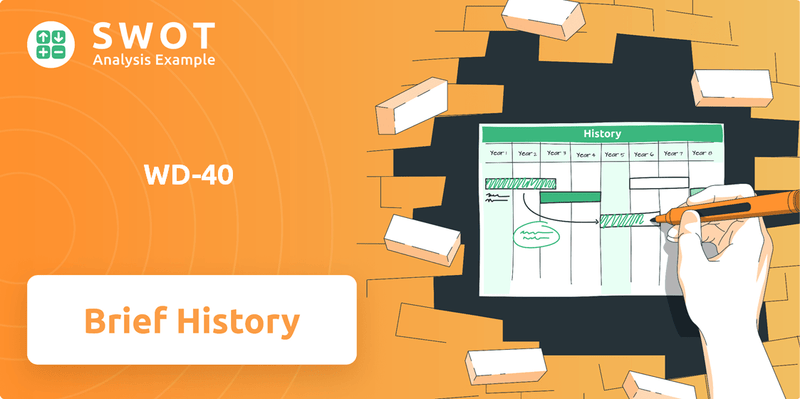
The WD-40 company's early focus on the aerospace industry, specifically creating a rust-preventative for missile parts, showcases a strategic understanding of market needs. This initial WD-40 product, designed to displace water, quickly found diverse WD-40 uses beyond its original intent. This foundational approach set the stage for the multi-purpose product that would eventually become a staple in homes and workshops worldwide, marking a significant milestone in the company's history.
What is the WD-40 Founding Story?
The story of the WD-40 Company, a household name, began on September 23, 1953, in San Diego, California. Initially known as the Rocket Chemical Company, the enterprise was the brainchild of Norm Larsen, Gordon Bell, and John Barden.
Their primary objective was to develop a rust-preventative solvent and degreaser. This was to protect the outer skin of the Atlas Missile from corrosion. This need within the aerospace industry set the stage for the creation of what would become a globally recognized product.
The name 'WD-40' itself is an acronym, standing for 'Water Displacement, 40th formula.' This reflects the painstaking process of perfecting the product. The team experimented with numerous formulations before arriving at the successful blend.
The company's early days involved a direct-to-business (B2B) model, supplying the product to industrial clients. The initial product was the WD-40 Multi-Use Product, sold in bulk.
- The founders meticulously documented each formulation attempt.
- The 40th attempt proved successful, giving the product its name.
- Initial funding came from the founders, leveraging their expertise.
- The Cold War and the aerospace industry provided a suitable environment.
The company's early focus was on serving clients like Convair. The initial funding for the WD-40 Company was primarily through bootstrapping. The founders leveraged their expertise in chemistry and business to launch the company. The cultural backdrop of the Cold War and the growing aerospace sector in Southern California created an ideal environment for a company specializing in chemical solutions for military applications. The company's early success can be seen as a result of its ability to meet the specific needs of the aerospace industry, which was experiencing significant growth during that time.
The Marketing Strategy of WD-40 has evolved significantly since its inception. The company's ability to adapt and innovate has been a key factor in its long-term success. The product's versatility and diverse applications have contributed to its widespread popularity.
In 2024, WD-40 Company reported net sales of approximately $570.7 million. This highlights the continued demand for its products. The company's long-term success is a testament to its ability to innovate and adapt to changing market conditions.
WD-40 SWOT Analysis
- Complete SWOT Breakdown
- Fully Customizable
- Editable in Excel & Word
- Professional Formatting
- Investor-Ready Format
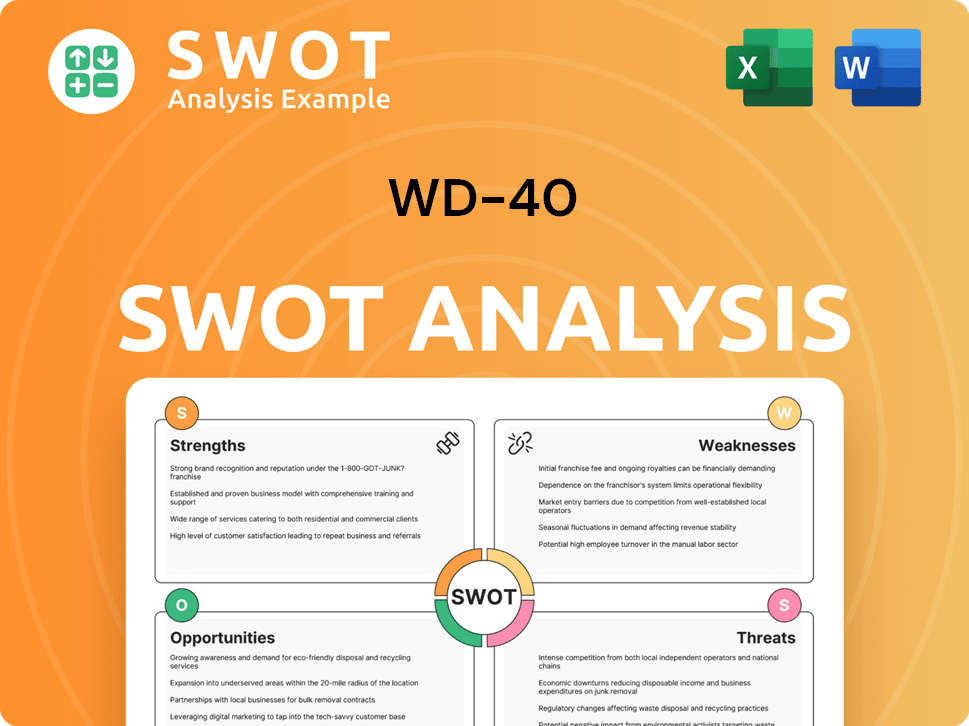
What Drove the Early Growth of WD-40?
The early growth of the WD-40 Company focused on refining and distributing its WD-40 formula to industrial clients. A significant turning point occurred in 1958 when Norm Larsen packaged the WD-40 product into aerosol cans, making it accessible to a broader consumer market. This shift was crucial for the company's expansion. The company's initial sales success was likely tied to securing contracts with aerospace and defense companies.
Initially, the WD-40 product was primarily aimed at industrial clients. This meant the company concentrated on bulk sales and specialized applications. The focus was on providing a solution for specific industry needs, setting the stage for future diversification. This early phase was critical for establishing the product's reputation for effectiveness.
The introduction of the aerosol can in 1958 was a game-changer. It transformed WD-40 from an industrial product to a consumer-friendly item. This packaging innovation made the product accessible to a wider audience, leading to increased sales and brand recognition. This strategic move opened new markets.
The company likely achieved its first major sales milestones by securing contracts with aerospace and defense companies. These contracts provided a stable revenue stream and validated the product's effectiveness in demanding environments. Securing these contracts was a crucial step in the WD-40 origin story.
By 1960, the company had grown to seven employees and was selling approximately 45 cases of WD-40 per day from its San Diego facility. The entry into the retail market with the aerosol can opened new geographical and product categories. In 1969, the company was renamed WD-40 Company, reflecting the success of its flagship WD-40 product. The company's mission is described in Mission, Vision & Core Values of WD-40.
WD-40 PESTLE Analysis
- Covers All 6 PESTLE Categories
- No Research Needed – Save Hours of Work
- Built by Experts, Trusted by Consultants
- Instant Download, Ready to Use
- 100% Editable, Fully Customizable
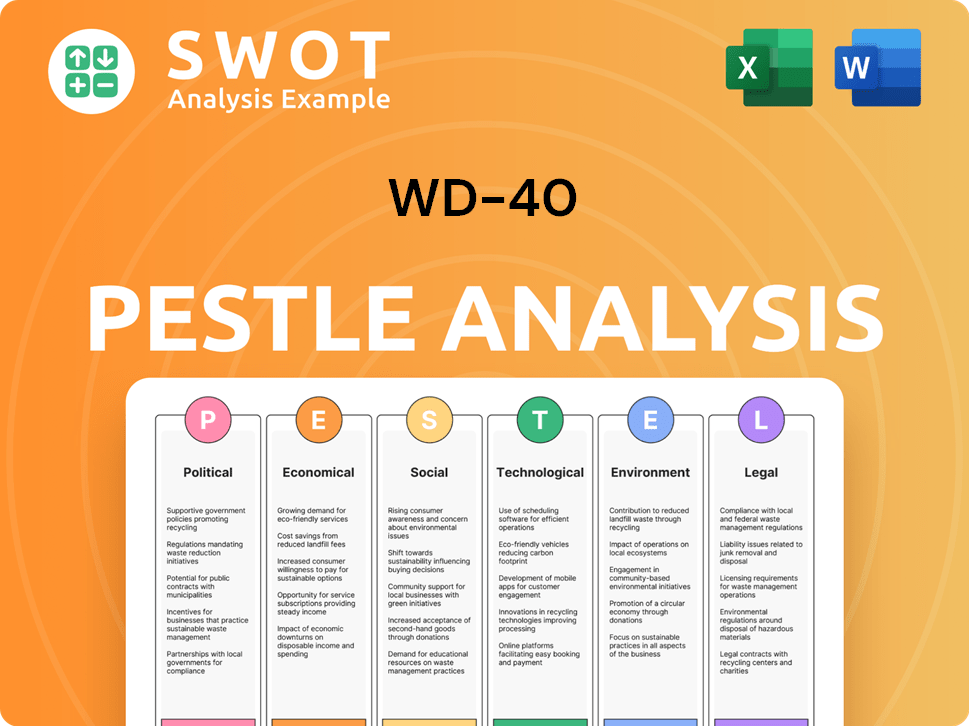
What are the key Milestones in WD-40 history?
The WD-40 company's journey is marked by significant milestones, including the development of its flagship product and strategic expansions. From its WD-40 origin in the aerospace industry to its current global presence, the company has consistently adapted and innovated to meet market demands.
| Year | Milestone |
|---|---|
| 1953 | The original formula for WD-40 was developed by the Rocket Chemical Company to prevent rust and corrosion. |
| 1960 | The WD-40 product was first sold in aerosol cans, making it accessible to consumers. |
| 1969 | The company was officially incorporated as the WD-40 Company. |
| 2005 | The 'Smart Straw' was introduced, offering a permanently attached straw for easier application. |
| 2024 | The WD-40 Specialist Degreaser was launched, expanding the product line for professional users. |
WD-40 has consistently focused on product innovation to meet evolving consumer needs. The introduction of the aerosol can in 1960 was a pivotal moment, broadening the WD-40 uses beyond industrial applications.
The shift to aerosol packaging in 1960 was a game-changer, making the WD-40 product accessible to a wider audience. This innovation significantly boosted sales and expanded the WD-40's market reach.
The 'Smart Straw' feature, introduced in 2005, addressed a common user frustration. This innovation improved the ease of use and application of the WD-40 product.
The development of the WD-40 Specialist line offered specialized solutions. This expansion allowed the company to cater to specific needs, such as rust removal and lubrication.
Ongoing efforts to refine and enhance existing products have been a constant. This commitment ensures that WD-40 remains effective and relevant.
Effective marketing strategies have been key to maintaining brand recognition. This includes highlighting the versatility and value of the WD-40.
The launch of new products, such as the WD-40 Specialist Degreaser in 2024, demonstrates the company's ability to innovate. This expansion helps the company to stay relevant in a competitive market.
WD-40 has faced challenges, including market competition and economic downturns. However, the company has demonstrated resilience through brand loyalty and strategic initiatives.
The lubricant and maintenance product market is highly competitive. WD-40 has met this challenge by focusing on brand recognition and product differentiation.
Economic fluctuations can impact consumer spending on maintenance products. WD-40 has weathered these by maintaining a strong brand and offering value.
Disruptions in the supply chain can affect production and distribution. The company has addressed these issues through careful planning and diversification.
Evolving consumer preferences require continuous adaptation. WD-40 has responded by innovating and expanding its product offerings.
Growing environmental awareness influences product development and marketing. The company is focused on sustainable practices and eco-friendly formulations.
Keeping the brand relevant in a dynamic market is an ongoing challenge. WD-40 continues to invest in marketing and product development.
The WD-40 Company's history shows a commitment to innovation and adaptability. For more insights into the company's strategic approach, consider reading about the Target Market of WD-40.
WD-40 Business Model Canvas
- Complete 9-Block Business Model Canvas
- Effortlessly Communicate Your Business Strategy
- Investor-Ready BMC Format
- 100% Editable and Customizable
- Clear and Structured Layout
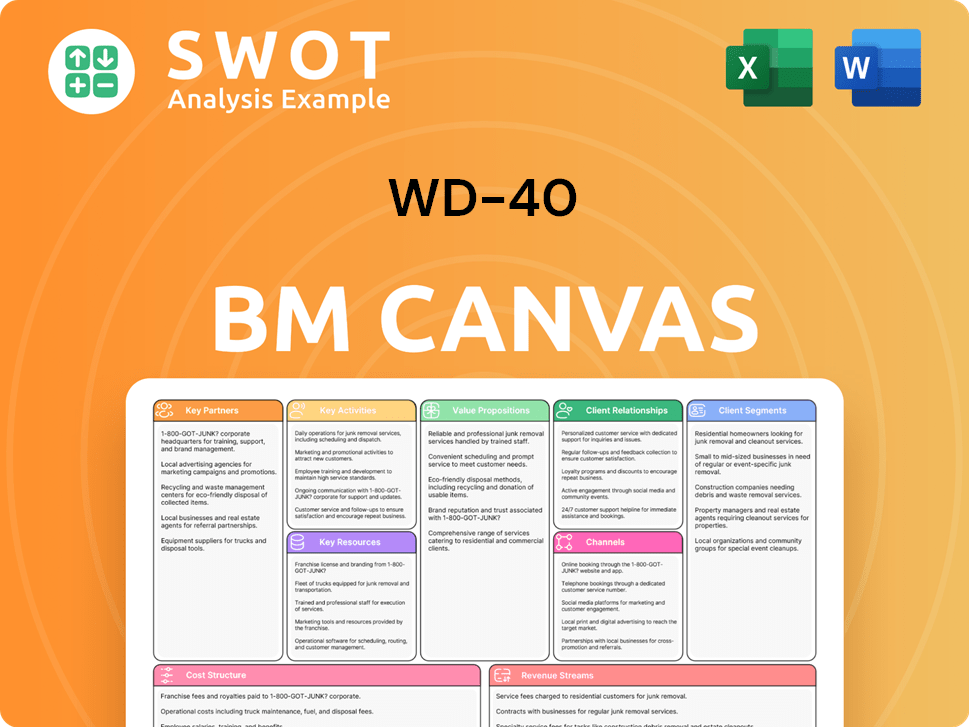
What is the Timeline of Key Events for WD-40?
The WD-40 company has a rich history, marked by significant milestones that have shaped its global presence. From its humble beginnings in a small lab to its current status as a household name, the journey of WD-40 is a testament to innovation and adaptability. The WD-40 product, initially developed for the aerospace industry, quickly found its way into homes and workshops worldwide, becoming synonymous with problem-solving and versatility. This growth is detailed further in Growth Strategy of WD-40.
| Year | Key Event |
|---|---|
| 1953 | Rocket Chemical Company was founded in San Diego, California, marking the WD-40 company founding. |
| 1953 | The WD-40 Multi-Use Product formula was perfected after 40 attempts, leading to the WD-40 origin. |
| 1958 | Norm Larsen packaged WD-40 into aerosol cans, preparing it for the consumer market. |
| 1960 | The WD-40 Multi-Use Product was officially launched into retail stores, expanding WD-40 uses. |
| 1969 | Rocket Chemical Company was officially renamed WD-40 Company. |
| 1993 | The company celebrated its 40th anniversary, with the product sold in over 100 countries. |
| 2005 | The 'Smart Straw' feature was introduced for the WD-40 Multi-Use Product. |
| 2011 | The WD-40 Specialist line of products was launched. |
| 2023 | The 70th anniversary of the WD-40 Multi-Use Product was celebrated. |
| 2024 | WD-40 Specialist Degreaser was launched. |
The WD-40 company is focused on expanding its presence in emerging markets. This includes increasing distribution networks and tailoring marketing strategies to suit local preferences. The goal is to make WD-40 products available to a broader customer base worldwide.
WD-40 continues to develop new products within its 'Specialist' and other lines. The company aims to address evolving consumer and industrial needs. This includes research and development to create specialized solutions for various applications.
WD-40 is leveraging digital marketing and e-commerce to reach a wider audience. This includes enhancing online presence, improving user experience, and expanding online sales channels. The company is using digital platforms to connect with customers.
Analyst predictions suggest continued steady growth for WD-40 Company. Net sales for fiscal year 2024 are projected to be between $570 million and $600 million. The company's financial health reflects its strong brand and market position.
WD-40 Porter's Five Forces Analysis
- Covers All 5 Competitive Forces in Detail
- Structured for Consultants, Students, and Founders
- 100% Editable in Microsoft Word & Excel
- Instant Digital Download – Use Immediately
- Compatible with Mac & PC – Fully Unlocked
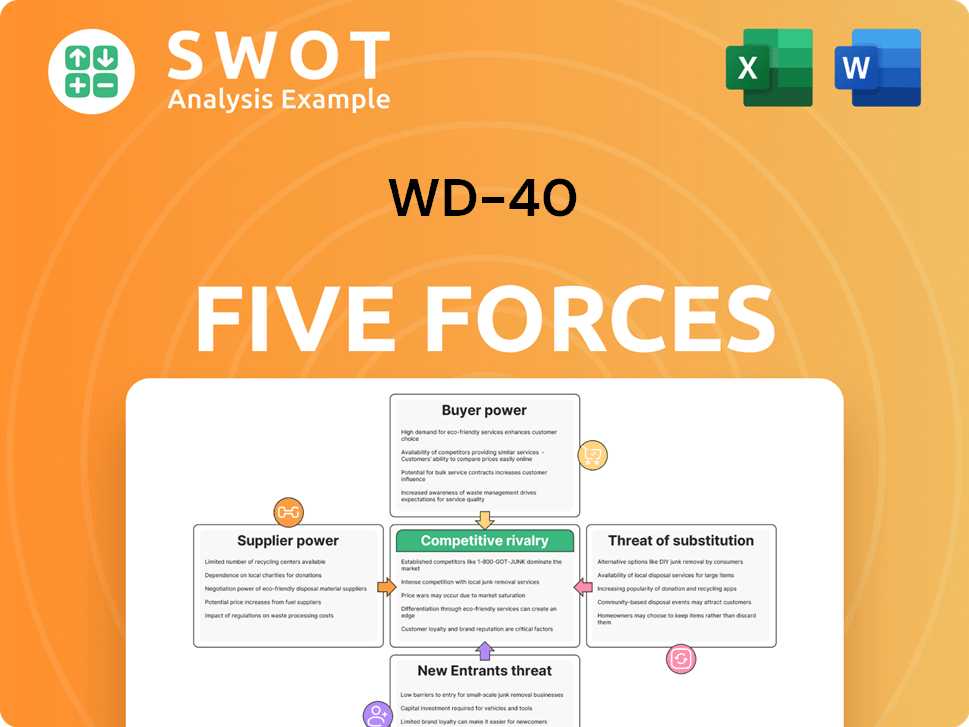
Related Blogs
- What is Competitive Landscape of WD-40 Company?
- What is Growth Strategy and Future Prospects of WD-40 Company?
- How Does WD-40 Company Work?
- What is Sales and Marketing Strategy of WD-40 Company?
- What is Brief History of WD-40 Company?
- Who Owns WD-40 Company?
- What is Customer Demographics and Target Market of WD-40 Company?
Disclaimer
All information, articles, and product details provided on this website are for general informational and educational purposes only. We do not claim any ownership over, nor do we intend to infringe upon, any trademarks, copyrights, logos, brand names, or other intellectual property mentioned or depicted on this site. Such intellectual property remains the property of its respective owners, and any references here are made solely for identification or informational purposes, without implying any affiliation, endorsement, or partnership.
We make no representations or warranties, express or implied, regarding the accuracy, completeness, or suitability of any content or products presented. Nothing on this website should be construed as legal, tax, investment, financial, medical, or other professional advice. In addition, no part of this site—including articles or product references—constitutes a solicitation, recommendation, endorsement, advertisement, or offer to buy or sell any securities, franchises, or other financial instruments, particularly in jurisdictions where such activity would be unlawful.
All content is of a general nature and may not address the specific circumstances of any individual or entity. It is not a substitute for professional advice or services. Any actions you take based on the information provided here are strictly at your own risk. You accept full responsibility for any decisions or outcomes arising from your use of this website and agree to release us from any liability in connection with your use of, or reliance upon, the content or products found herein.